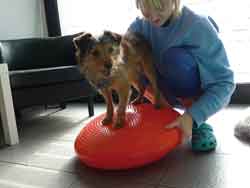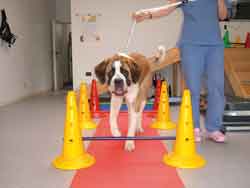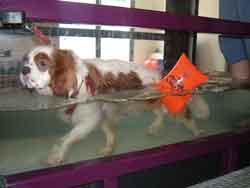In Reggio Emilia, on 22 Adua Street, in a modern and
functional structure called Dog Fitness, Ludovica Dragone has been working
for a few years to relieve the physical and neurological pain of dogs
through leading-edge physiotherapy and rehabilitative techniques.
Guide
dogs for blind people undergo continuous psycho-physiological stress, and
their life conditions on a daily basis are rather unusual for dogs. Can
there be any advantages or remedies for them in facilities geared towards
Dog Fitness?
Let us try to understand this through the words of the
person directly involved who answered a few of our
questions.
How many dogs receive treatment here in the
centre every year?
We see every year between 200 and 250 new
patients; we also have all the other dogs that we help in getting older
more serenely and who regularly visit us for rehabilitative
treatment.
How long ago did the centre open and what was the
rationale behind this?
The centre opened in the fall of 2004.
What motivated me in undertaking this project is the idea that if
physiotherapy is fundamental for people to whom you can say 'do this and
don't do that', surely it can be done for dogs as well.
The veterinarian is also constantly improving her own
methods of surgery, in the field of orthopaedics or neurosurgery, and many
of these surgery interventions cannot lead to the same results if the
patient does not have an adequate follow-up. "We work towards having good
surgery results so that dogs will improve as best as possible and as
quickly as possible."
What are the most recurring pathologies and in
what cases have you obtained the best results?
Our patients
generally have orthopaedic or neurological problems. Among the orthopaedic
pathologies, certainly hip dysplasia is what we see most often. Daily, we
have to treat dogs affected by this pathology, whether because they are
older dogs and the symptoms are obvious and the pain in the
articulations is such that their lifestyle is altered, or because they are
young dogs and, considering the absence of symptoms, we try to improve the
muscle mass to provide greater well-being and limit the progression of the
pathology.
Among the neurological pathologies, the management of
post-surgery in patients that had slipped discs is without a doubt the
pathology that we most often have to deal with. We have had great results
even with patients that, because of the important damage to their bone
marrow, had lost all sensitivity in their back limbs and their brain was
no longer able to command their own legs.
Through proper rehab, we have obtained a good
success rate with dogs that are now able to walk independently again, even
with patients that once, when they were well, were put in a small
trolley.
What is the training one must have in order to manage
a centre like “Dog Fitness”?
I studied as a veterinarian and
did my thesis on rehabilitative physiotherapy for dogs. I studied in the
United States, at the University of Tennessee College of Veterinary
Medicine and in North Carolina. To further my knowledge in the field of
rehabilitation of domestic animals, I completed a course in the United
States and obtained in 2004 from the University of Tennessee a degree as a
Certified Canine Rehabilitation Practitioner (CCRP).
I participated,
in the capacity of presenter, in national and international courses,
seminars and conferences on the subject of rehabilitative physiotherapy
for domestic animals.
I have been co-examiner for students doing their
thesis at the universities of Bologna, Padova and Parma.
Since 2007, I
am responsible for the study group SCIVAC in rehabilitative
physiotherapy.
Are there any suggestions or tips to foster good
physical health even for guide dogs, considering that they are often
obligated to a sedentary life and few opportunities for free
mobility?
Without a doubt, weight control is the first step in
order to help a dog live a healthier life and grow old better. Many
pathologies, whether they be orthopaedic or neurological, are
worsened by excess weight. Three or four slow walks a day can be an
excellent way to keep in shape even for a guide dog. It is not necessary
to go for a quick run though it can once in a while be a happy and
pleasant time for the dog.
Could a blind person practice
physical rehabilitation therapy on the dog, considering the special
movements that have always been shown in physiotherapy or
massotherapy?
Even a blind person could do the specific manual
treatment on his own dog. It would only be necessary for the veterinarian
to see the dog more frequently in order to regularly monitor results and
eventual progress, and to modify accordingly the therapeutic
protocol.
Is there a story about a dog or a special
event that you would like to share with the readers of Vedere
Oltre?
Dogs are like people, there are those who, because of
their own story or because they are simply "like that" without having done
anything in particular, have a special place in your heart and you never
forget them. 
Every dog is special and that is why I think I can
remember the name of all my patients! Given the name of your magazine,
however, certainly Mirtillo deserves to be mentioned. It is the story of a
Cocker that at the age of one year and a half became my life companion.
The previous owners of this Cocker were not able to see the dog in a
different way, beyond its disability (when it arrived here, it could not
walk because of a vertebral luxation), and they could not imagine that his
life could be full of happiness and autonomy. They did not believe and did
not have the patience and the trust necessary in this case and so they
gave up. Now Mirtillo is like me, he stayed with me and became the boss in
the house and is part of the welcoming committee of Dog Fitness (I love to
kid about his intrusive nosiness each time a new "guest" arrives), and he
never leaves me, staying with me 24 hours a day. Never a day goes by that
I don't think that he could have not existed, and never a day goes by
without my being thankful because he is with me, absolutely independent
and happy.
Dr. Ludovica Dragone
Holder of a
degree in veterinary medicine from the University of Parma, year
2001-2002, with a thesis on
rehabilitative physiotherapy for
dogs.
Following her degree, she trained at the University of Tennessee
with Professor D. Millis and in North Carolina with Professor D.
Marcellin.
Certification as a Canine Rehabilitation Practitioner
(CCRP) from the University of Tennessee. At the present time, she is the
manager of the community clinic Dog Fitness in Reggio Emilia dealing
predominantly with dog rehabilitation in neurology and
orthopaedics.
Ambulatorio Veterinario Dog Fitness
Trattamenti di
Fisioterapia Riabilitativa
Manuali e Strumentali
Via Adua 24/a –
42100 Reggio Emilia
Tel. 0522 924310
Fax. 0522 924310
Email: info@dogfitness.it